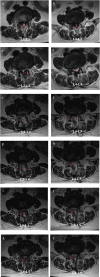Does the number of drain tubes influence the formation of postoperative spinal epidural hematoma following biportal endoscopic unilateral laminotomy for bilateral decompression (BE-ULBD) in patients with two-level adjacent lumbar spinal stenosis? a prospective randomized study
- PMID: 40551242
- PMCID: PMC12186364
- DOI: 10.1186/s13018-025-06042-1
Does the number of drain tubes influence the formation of postoperative spinal epidural hematoma following biportal endoscopic unilateral laminotomy for bilateral decompression (BE-ULBD) in patients with two-level adjacent lumbar spinal stenosis? a prospective randomized study
Abstract
Background: The formation of postoperative spinal epidural hematoma (POSEH) following lumbar spinal surgery is a potentially serious complication. The efficacy and necessity of prophylactic postoperative drain tubes in preventing symptomatic postoperative spinal epidural hematoma (SPOSEH) after lumbar spinal decompression remain subjects of ongoing debate. The objective of this study is to investigate the potential impact of the number of drain tubes on POSEH following biportal endoscopic unilateral laminotomy for bilateral decompression (BE-ULBD) in patients of two-level adjacent lumbar spinal stenosis.
Methods: A prospective randomized study was conducted involving 89 patients with two-level adjacent lumbar spinal stenosis who underwent BE-ULBD. Patients were divided into two groups: Group A (one drain tube) and Group B (two drain tubes). Demographic data were collected, including preoperative visual analog scale (VAS) scores for leg pain and preoperative blood pressure (BP). Postoperative BP was recorded. The primary outcome was the cross-sectional area (CSA) of POSEH assessed at 72 h postoperatively. Secondary outcomes included postoperative VAS scores for leg pain, volume of drainage output, and length of hospital stay.
Results: A total of forty-three patients were assigned to Group A, while forty-six patients were assigned to Group B. The demographic characteristics of the patients in both groups were comparable. No significant differences were observed between the two groups regarding the CSA of POSEH. However, a significantly greater volume was noted in Group B (P = 0.015). There were no significant differences between the groups for other secondary outcomes, including postoperative VAS scores for leg pain (P = 0.584), and length of hospital stay (P = 0.428).
Conclusions: More drain tubes may result in statistically significant output but not clinically significant differences in influencing the formation of POSEH following BE-ULBD for two-level adjacent lumbar spinal stenosis.
Trial registration: The study was retrospectively registered in ClinicalTrials.gov on March 1, 2024, with the registration number NCT06290791.
Keywords: Decompression surgery; Drain tube; Lumbar spinal stenosis; Spinal epidural hematoma.
© 2025. The Author(s).
Conflict of interest statement
Declarations. Ethics approval and consent to participate: The study received review and approval from the institutional review board and ethics committee of the Fourth Affiliated Hospital of the School of Medicine, under decision number K2020214. Written informed consent was obtained from all patients or their legal guardians prior to participation in the study. Consent for publication: Written informed consent for the publication of this study was obtained from all participants involved. Competing interests: The authors declare no competing interests.
Figures





Similar articles
-
Comparison of Biportal Endoscopic Technique and Conventional Unilateral Laminectomy for Bilateral Decompression (ULBD) for Multi-Level Degenerative Lumbar Spinal Stenosis in Elderly People.Orthop Surg. 2025 Aug;17(8):2302-2312. doi: 10.1111/os.70084. Epub 2025 Jun 17. Orthop Surg. 2025. PMID: 40528425 Free PMC article.
-
Perioperative Enhanced Recovery After Surgery (ERAS) Clinical Pathway for Unilateral Biportal Endoscopy with Unilateral Laminotomy for Bilateral Decompression.Orthop Surg. 2025 Sep;17(9):2699-2707. doi: 10.1111/os.70117. Epub 2025 Jul 21. Orthop Surg. 2025. PMID: 40692137 Free PMC article.
-
Comparison of short-term clinical outcomes and muscle injury in patients with lumbar spinal stenosis undergoing arthroscopic-assisted uni-portal spinal surgery, unilateral biportal endoscopic surgery, and percutaneous interlaminar lumbar discectomy: a six-month follow-up.J Orthop Surg Res. 2025 Jul 21;20(1):684. doi: 10.1186/s13018-025-06088-1. J Orthop Surg Res. 2025. PMID: 40691813 Free PMC article.
-
Surgical options for lumbar spinal stenosis.Cochrane Database Syst Rev. 2016 Nov 1;11(11):CD012421. doi: 10.1002/14651858.CD012421. Cochrane Database Syst Rev. 2016. PMID: 27801521 Free PMC article.
-
Effectiveness of posterior decompression techniques compared with conventional laminectomy for lumbar stenosis.Eur Spine J. 2015 Oct;24(10):2244-63. doi: 10.1007/s00586-015-4098-4. Epub 2015 Jul 17. Eur Spine J. 2015. PMID: 26184719
References
-
- Davidoff CL, Rogers JM, Simons M, Davidson AS. A systematic review and meta-analysis of wound drains in non-instrumented lumbar decompression surgery. J Clin Neuroscience: Official J Neurosurgical Soc Australasia. 2018;53:55–61. - PubMed
-
- Fujita N, Michikawa T, Yagi M, Suzuki S, Tsuji O, Nagoshi N, et al. Impact of lumbar hypolordosis on the incidence of symptomatic postoperative spinal epidural hematoma after decompression surgery for lumbar spinal Canal stenosis. Eur Spine J. 2019;28(1):87–93. - PubMed
-
- Sokolowski MJ, Garvey TA, Perl J 2nd, Sokolowski MS, Akesen B, Mehbod AA, et al. Postoperative lumbar epidural hematoma: does size really matter? Spine. 2008;33(1):114–9. - PubMed
Publication types
MeSH terms
Associated data
Grants and funding
LinkOut - more resources
Full Text Sources
Medical

